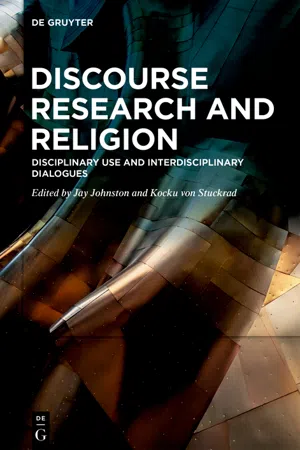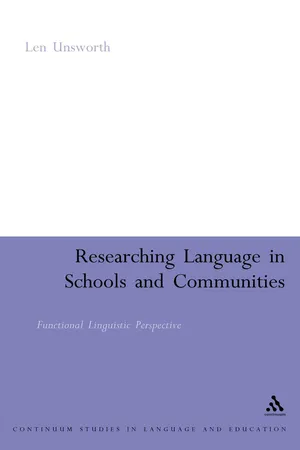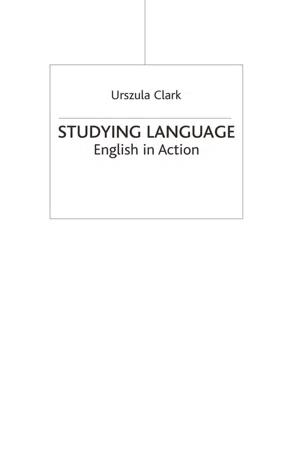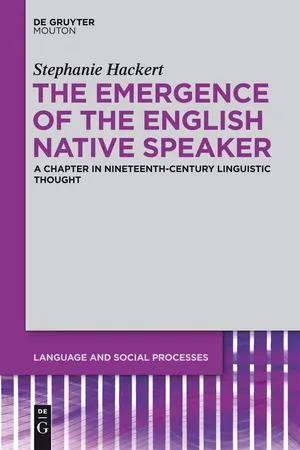Languages & Linguistics
Norman Fairclough
Norman Fairclough is a prominent British linguist known for his work in critical discourse analysis (CDA). He has contributed significantly to the study of language and power, emphasizing the role of language in shaping social relations and ideologies. Fairclough's approach to CDA involves analyzing language use in various contexts to uncover underlying power structures and social inequalities.
Written by Perlego with AI-assistance
Related key terms
1 of 5
5 Key excerpts on "Norman Fairclough"
- eBook - ePub
Discourse Research and Religion
Disciplinary Use and Interdisciplinary Dialogues
- Jay Johnston, Kocku von Stuckrad(Authors)
- 2020(Publication Date)
- De Gruyter(Publisher)
Whose Voice Is This? The Multicultural Drama from CDA and DST Perspectives
Frans WijsenThe word ‘discourse’ seems to have become a fad in academia. More than twenty journals have the word ‘discourse’ in their titles, and various book series as well. Numerous authors use the word ‘discourse’ in various ways, often without clarifying what exactly they mean. More or less the same applies to the label ‘discourse analysis.’ ‘Critical discourse analysis’ (CDA) is a distinct approach within the broader field of discourse studies that emerged in the early 1990s in the work of scholars such as Teun van Dijk, Ruth Wodak, Norman Fairclough, Theo van Leeuwen, and Gunther Kress. Initially known as critical linguistics, it has become widespread in the social sciences and the humanities (Wodak 2001 , 4–9).CDA takes its main inspiration from Michel Foucault. But within the field of critical discourse analysis, there is a difference between authors who strictly follow Foucault and authors who elaborate on his work, stating that Foucault is too abstract and too deterministic (Fairclough 1992 , 56–57). There are authors who are strictly text oriented, authors who focus on cognition and classification, and authors who are interested in the social conditions and social effects of social classifications (Wetherell 2001 ; Breeze 2011 ).In this chapter, I explore the use and usefulness of the three-dimensional model of CDA, as developed by Norman Fairclough (1992 , 2001 , 2003 ). I am not the first or the only one to do so. Other scholars who have done so include Jørgensen and Phillips (2002 , 60–95), Lock (2004) , and Hjelm (2014) . Heather (2000) , Moberg (2016) , and myself (Wijsen 2010 ), among others, have used this approach in the academic study of religion.I started using CDA in 2007, in a research project on religious discourse, social cohesion, and conflict, studying the “clash of civilizations” rhetoric in three countries. I was able to employ three junior researchers who successfully completed their doctoral studies using critical discourse analysis. We focused on culturally salient keywords to understand the discursive nature of societal changes in Tanzania (Wijsen and Ndaluka 2012 ), Indonesia (Wijsen and Cholil 2014 ), and the Netherlands (Wijsen and Vos 2015 - eBook - PDF
Researching Language in Schools and Communities
Functional Linguistic Perspectives
- Len Unsworth(Author)
- 2005(Publication Date)
- Continuum(Publisher)
12 Close reading: functional linguistics as a tool for critical discourse analysis /. R. Martin 12.1 Critical discourse analysis Critical discourse analysis (CDA) is an approach to discourse analysis which focuses on inequality in society and the ways in which texts are used to realize power and ideology. CDA is concerned not only with analysing texts to investigate power, but also with finding ways of redressing inequal-ities. The leading figures in CDA have involved themselves in issues such as racism, sexism, colonialism and environmentalism (Caldas-Coulthard and Coulthard 1996, Chilton 1985, Fairclough 1995a, Fairclough and Wodak 1997, Lemke 1995, van Dijk 1991, Wodak 1987a, b, Wodak et al 1990). They have also addressed issues in the field of language in educa-tion, where questions of inequality and how to redress inequality are always present (Cope and Kalantzis 1993, Fairclough 1992a, Giblett and O'Carroll 1990, New London Group 1996, Walton 1996, Wodak et al. 1989). CDA and systemic functional linguistics (SFL) have been closely associ-ated since the pioneering work of critical linguists at East Anglia (Fowler et al. 1979, Fowler 1996). Fairclough (1995a: 6-10) notes that SFL is a congenial theory for CDA because it is multifunctional, well adapted for text analysis and concerned with relating language to social context. Aus-tralian theorists have used and adapted SFL to gain a critical perspective on texts in a wide range of registers (e.g. Hasan 1996, Kress 1985/1989, Martin 1986, Melrose 1996, Schirato and Yell 1996, Thibault 1991, Threadgold 1997), including work of special educational significance (Christie 1999, Christie et al. 1991, Lee 1996, Martin 1985/1989, 1990). - eBook - PDF
Social Constructionism
Sources and Stirrings in Theory and Practice
- Andy Lock, Tom Strong(Authors)
- 2010(Publication Date)
- Cambridge University Press(Publisher)
(van Dijk, 1993: 28) Critical discourse analysis (CDA) is a relatively new field of research, which has mostly developed since the early 1990s. Sometimes the term ‘critical linguistics’ is used interchangeably with CDA, and at the heart of CDA is a view that what matters is how language is used in context. Most of us seldom consider the extent to which discourses dominate our ways of thinking and talking, but for most CDA practitioners, everyday language-use is hardly a neutral activity. Borrowing from critical theorists such as Habermas, Gramsci or Althusser, CDA examines how particular ideologies are pursued through people’s communicative interactions. To that end CDA can be seen as a tool in examining and subverting how language serves power relations. How, for example, has the western conception of female beauty become so dominated by particular ways of representing it? CDA often sees communicative interaction as a contest for discursive domi- nance. A good example of this can be seen in the work of Norman Fairclough and his colleagues who study, for example, how the discourse of the ‘new global economy’ features in different communicative contexts. This ‘neo-liberal’ dis- course, for them, is pursued in ways that diminish democratic rights and encour- age governments to abandon costly social services, all as part of ‘freeing-up’ the marketplace. Whether examining political speeches, advertisements, everyday talk, the ubiquity of corporate logos, or changes in government and corporate policies, this group of critical discourse analysts aims to show how the language of the ‘new economy’ plays out in terms of human interaction, and impacts on people’s shared ways of living. - eBook - PDF
Studying Language
English in Action
- Urszula Clark(Author)
- 2017(Publication Date)
- Red Globe Press(Publisher)
CHAPTER Critical Discourse Analysis 4 ❙ 4.1 Introduction Critical discourse analysis (CDA) investigates the structures of power that underlie all acts of speech and writing, and is therefore concerned with the politics of language. It analyses the ways in which speech and writing and the practices associated with them construct and shape reality and the world in which we live. It is ‘critical’ in the sense that it encourages readers to ques-tion assumptions and not to take anything for granted, to analyse social issues as they are constructed in discourse and how discourse contributes to the construction of society. It draws on sociological and critical theory as well as linguistic theory when considering power relations, including those of gender, ethnicity and social class. CDA also differs from the other fields of applied linguistics discussed in this book in that its approaches and analyti-cal methods allow for the study of both spoken and written language in all genres. The precise relationship between language and reality is a matter of much debate (see Chapman, 2006, ch. 4). That the two are closely connected and in many ways inseparable is undeniable, but how they act upon each other is unclear. During the twentieth century, linguists (most notably the French lin-guist Ferdinand de Saussure, 1916 and the Russian linguist Mikail Bakhtin, 1981), anthropologists (such as the Americans Edward Sapir, 1921, and Benjamin Whorf, 1956), philosophers (for example the German philosopher Ludwig Wittgenstein, 1951) and cultural theorists (for instance the French theorist Michel Foucault, 1972), showed that language plays an important part not only in structuring but also in creating reality (for more about this see: Chapman, 2006, section 6.4). If it is indeed the case that language struc-tures and creates rather than reflects reality, then the source of power and 137 - eBook - PDF
The Emergence of the English Native Speaker
A Chapter in Nineteenth-Century Linguistic Thought
- Stephanie Hackert(Author)
- 2012(Publication Date)
- De Gruyter Mouton(Publisher)
It thus offers a “transdisciplinary” (Blackledge 2005: 6–7) way of looking at the linguistic character of social categories, structures, and processes. CDA is closely associated with the names Fairclough (e.g., 1992, 1995, and 2001), van Dijk (e.g., 1993), and Wodak (e.g., Wodak et al. 1999), but numer-ous other researchers have recently published studies that can be subsumed under the label (cf. Blackledge 2005: 239–248). As the name implies, an important component of CDA is the critical stand-point adopted. As van Dijk (2001: 96) puts it, CDA is “discourse analysis with an attitude.” In other words, “CDA emphatically opposes those who abuse text and talk in order to establish, confirm or legitimate their abuse of power” (Black-abstract ideas; for each variety of gum-tree and wattle-tree, &c., &c., they had a name, but they had not equivalent for the expression ‘a tree.’” 46 Identities, ideologies, and discourse ledge 2005: 3). Whereas a primarily critical standpoint by itself will, of course, not necessarily generate new insights into the function of language in social life, CDA also implies a number of theoretical and methodological premises that have proved fruitful in the investigation to be described in the following chapters. First, CDA views language as social practice. This means that language use is always socially determined and has social effects, i.e., language activity is not merely a reflection of social processes, structures, and categories, but is a crucial part of the latter and at least partly co-determines them. Discourse, as a form of language use, is thus socially conditioned as well as socially constitutive, and this, at least according to Fairclough (2001: 19), is what differentiates the notions of discourse and text. If discourse is socially constitutive, however, it may either help to sustain and reproduce social identities and relations or contribute to transforming them.
Index pages curate the most relevant extracts from our library of academic textbooks. They’ve been created using an in-house natural language model (NLM), each adding context and meaning to key research topics.




